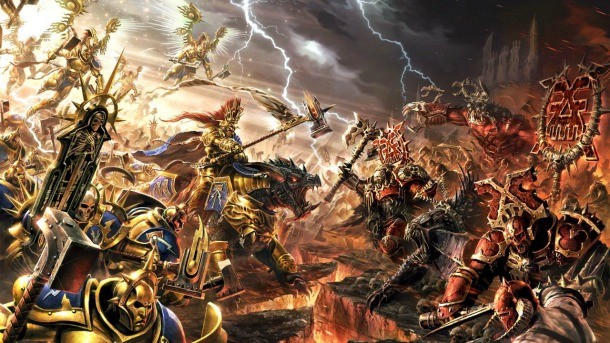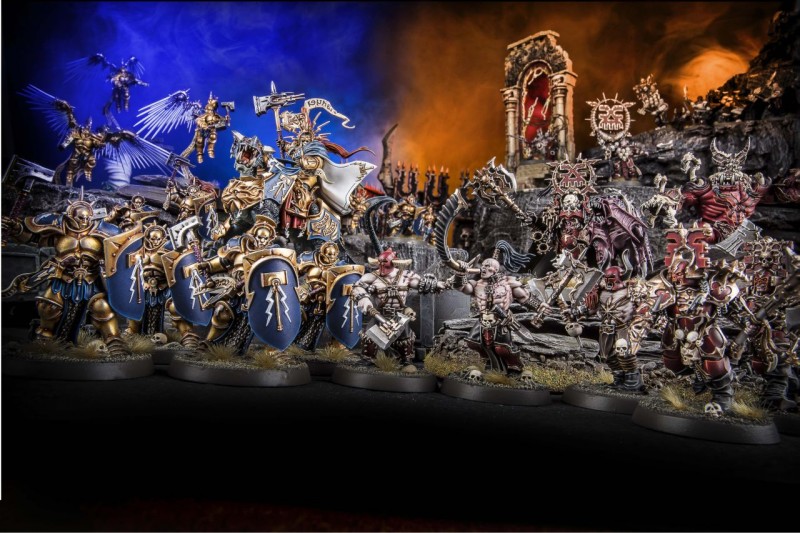Games Workshop Reinvents Warhammer

Warhammer has always had an imposing barrier to entry. The long-running miniatures property has been around since the early 1980s, with a seemingly endless flow of new figures, rules, and lore to comprehend. And yet, the quality of those intricate figures and the strength of a thoughtfully fostered community of gamers has kept the franchise alive for decades, broadening out into novels, video games, and more. At Games Workshop, after all these years, the game’s creators recently took a dramatic step, destroying the very world the game is based on. I recently visited with Games Workshop to learn what comes next, and the ways in which Warhammer is seeing its biggest reinvention ever in the Age of Sigmar.
I have a special perspective on Warhammer, but not one that is unique. As a longtime video game and tabletop game player, I’ve brushed against knowledge of Warhammer for years, but I’ve never fully embraced the title. I play other miniature-based experiences, and I’ve had my fair share of time running around in video game versions of the Warhammer universe. But like many fellow gamers, Warhammer has always seemed prohibitive. The long history of the fiction seems convoluted, the rules require a deep dedication, and the craft involved in preparing and painting the unpainted models is incredibly time and money intensive.
Games Workshop has a big challenge in front of it if it hopes to draw in players like myself, while simultaneously maintaining the enthusiasm of its devoted community of fans. The studio’s proposed solution is on the way later this month, with pre-orders opening today. Warhammer: Age of Sigmar represents the biggest fundamental change to the fantasy miniatures wargame that its creators have ever attempted.
While Age of Sigmar is a fresh jumping on point, it has its roots in the game’s most recent major storyline, The End Times. Within novels and game supplements, and over the course of many months, Games Workshop unfolded the apocalypse of its own world. Massive armies collided, magic was unleashed, and in the end, the Warhammer world was utterly destroyed.

In the wake of that conflagration, the energies unleashed produce the beginnings of a new universe. Eight mortal realms emerged, interconnected by a series of gates, as well as a ninth realm of chaos. The forces of Chaos in this new universe once again began their assault, and eventually overtook much of the mortal realms. The re-emergent god, Sigmar, withdrew into a signal celestial realm to consolidate his forces, and from here, he plans to strike back at Chaos and retake the realms.
Right from the start, the storyline of Age of Sigmar turns expectations around. Traditionally, the invading forces of Chaos must be repelled by the “good guys.” In the new game, Sigmar sends forth armies of newly forged immortal heroes, drawn from the detritus of the conquered realms, and aims to retake ground held by the rampaging forces of Chaos. The storyline is built to be an easy-to-understand story for newcomers, but one that draws on the old fiction, heroes, and gods for longtime players.
Perhaps more importantly, Age of Sigmar represents Games Workshop’s goal to tell a more robust ongoing story. Sigmar’s initial assault sends his army of Stormcast Eternals down to retake the Realm of Fire from the Khorne Bloodbound army. From this starting conflict, Games Workshop hopes to unfold an evolving tale with greater narrative direction and depth than they’ve previously included. In fact, I’m told that the first full year of storylines is already clearly planned out.
[Next Page: The rules are changing]

For longtime players, the biggest surprises are undoubtedly the dramatic changes coming to rules presentation and structure. Previous versions of the game often presented hundreds of pages across multiple books, and sometimes required constant cross-referencing of unit rules and how they interacted with one another.
The new rules fit on four pages, and will be available for download free-of-charge to any and all players. These streamlined rules are built to offer tactical complexity but with an easy entry path. Beyond these base rules, every unit now has its own dedicated War Scroll – a sort of character sheet that offers all the information a player needs to run that figure in a battle, without the need to dig through books for disparate pieces of info.
Games Workshop not only plans to release War Scrolls for all of its new figures that are a part of the Age of Sigmar set, but also offer up War Scrolls for all the previous Warhammer figures that collectors may already own. If you’ve been collecting, assembling, and painting figures for years, the plan is that you’ll be able to download War Scrolls for your units for free from the internet, and then take those armies into battle. War Scroll Compendiums for older Warhammer armies will also be available in multiple languages.
To put it another way, if you’re not interested in purchasing new rules or miniatures, and you already have some of the old Warhammer figures, the new games system is open and free to try out.

The rules changes are built around the precepts of being easy to learn, but hard to master. In addition to the big addition of War Scrolls for each unit, miniatures are now less tied to formations or ranked up blocks, allowing for more free individual movement across the battlefield. In fact, the standard mini base has shifted from a square/rectangular shape to a circle/oval shape, which Games Workshop feels makes the figures simply look better. It’s not that you can’t bring square-based units into a battle, it’s just that the figure base and facing of the unit no longer matters as it did before.
Individual units used to have far more complex interactions, so that attacks between unit A and unit B were often dramatically different from attacks between unit A and unit C. Now, the complexity is packed into the individual figure – unit A’s actions should be the same, regardless of the enemy with which it is interacting.
Another huge change is the ability to have any units you want deployed in your army – you’re not tied to only using figures that are normally aligned. Classically aligned units will still have important buffs and bonuses tied to being deployed together, so players can still expect to keep armies largely intact. But in the name of tactical flexibility, if you want to throw in one or more unit from a different group, then go for it.
Finally, the base rules are now much more freeform in regards to balance. No point buy system governs what units you can deploy. Instead, players are meant to decide as they play how they want to set up their game, with guidance from the rules that suggest potentially exciting scenarios that players could try out. Out of the box, I’m told that Age of Sigmar is not built as a head-to-head tournament style game, in part because Games Workshop believes that players will create their own rules to govern how those more competitive scenes unfold. Instead, the developers have opted for a philosophy that gives more control to players; let them opt into additional restrictions, rather than being forced to opt out of hard-and-fast rules for how any given game should function. As such, the new Warhammer is built to encourage more cooperative conversation, narrative-driven experiences, and social oriented interactions.
[Next Page: The new boxed set]

Despite what Games Workshop hopes is a more robust and approachable set of rules and story, one thing that is not changing is the focus on Warhammer as a craft experience. The new Age of Sigmar boxed set still comes with unpainted, assembly-required miniatures, despite recent trends in other tabletop gaming circles towards pre-painted, assembled figures. The team believes that the process and pride that comes from preparing and growing your own customized army is core to the Warhammer experience, and has no plans to move away from that tenet of the game. With that said, the new rules include extensive sections on helping players get into the army building process, with advice on assembly, painting, and other aspects of miniature craft.
For players who do opt in to the new big box, the Age of Sigmar set is an impressive collection. Even with my limited experience with Warhammer minis, I can recognize the incredible level of detail that has gone into this new line. The boxed set is planned for a $125 price tag in the United States, but that hefty investment gets you 47 figures. Moreover, unlike many previous boxed Warhammer sets, far more of these figures represent large scale elite, hero, and monster figures, all of which look remarkable, as seen in the surrounding images. Games Workshop unabashedly proclaims that this is the most detailed boxed set of figures it has ever released. The boxed set also includes a book with background on lore and rules, a full collection of dice, model assembly instructions, the new streamlined four-page rules, and two rulers for measurement. If players are hesitant to go all in on the full new boxed set, it’s also worth remembering that any subsequent smaller figure sets will also have the available streamlined rules included, making it easier to enter at a lower price point and still engage with the game.
As a longtime member of various fan communities, I recognize the challenge that Games Workshop faces in attempting such a broad-reaching reinvention of its signature property. As a rule, established fans are suspicious of change, and they are often even more wary if that change is a move towards what seems like simplification. As an outside observer to the devoted Warhammer fan community, I can’t speak to whether Age of Sigmar maintains what fans love about the franchise. But my perspective also tells me that this is the first time in a long time that I feel like I could join in on the fun and share in the hobby. Moreover, the new game seems tactically engaging, narrative-rich, and visually striking. I’m thrilled to see Games Workshop take such a brave leap; now it only remains to be seen whether its community will also make the jump.


Get the Game Informer Print Edition!
Explore your favorite games in premium print format, delivered to your door.
- 10 issues per year
- Only $4.80 per issue
- Full digital magazine archive access
- Since 1991









